Hi Everyone!
Baby Bear is asking for your help voting for his book, Achoo! Why Pollen Counts. You see, he can't vote himself - but you can! EVERY vote counts.
Achoo! Why Pollen Counts is a 2015 Foreword Review INDIEFAB Finalist. You vote for the Readers' Choice by saying, Achoo! is my #INDIEFABFAVE in the comment section here: https://indiefab.forewordreviews.com/books/achoo-why-pollen-counts/
You can use you Facebook account, or create a Foreword Review account to leave your comment. It is very simple - and would mean the absolute World to Baby Bear and all his forest friends! Please also help spread the word and help me make this go viral. Voting ends May 20, 2016.
A HEARTFELT THANK YOU from: Baby Bear, Valerie Vole, Momma Bear, Sandy Spiderling, Zoe Zebra Butterfly, Honey Bee, Lili Ladybug, Sammy Snow Owl, and Shennen.
www.achoowhypollencounts.com
Viewing: Blog Posts Tagged with: pollen, Most Recent at Top [Help]
Results 1 - 9 of 9
Blog: the dust of everyday life (Login to Add to MyJacketFlap)
JacketFlap tags: Animals, BEE, BEAR, POLLEN, Shennen Bersani, #kidlitart, ARBORDALE, Add a tag
Blog: (Login to Add to MyJacketFlap)
JacketFlap tags: butterflies, Bats, nature books, honeybees, pollen, Special Days, pollinators, Achoo, Arbordale Posts, arbordale books, pollinator books, pollinator week, special days of the year, Add a tag
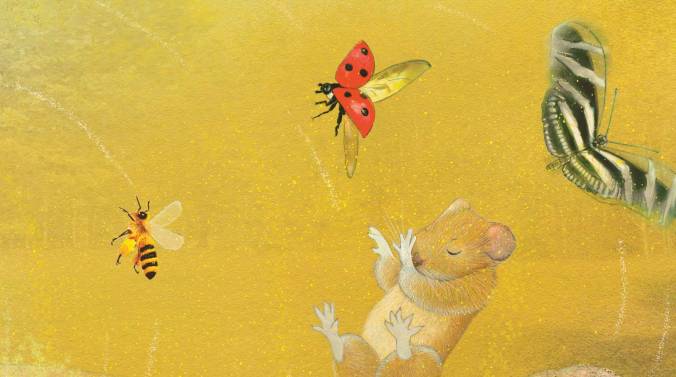 Where would the world be, if Baby Bear’s wish came true and all the pollen was to disappear? Well, many of his forest friends would be without food, and the bees and butterflies would have no reason to hop from flower to flower. That is why this week is pollinator week!
Where would the world be, if Baby Bear’s wish came true and all the pollen was to disappear? Well, many of his forest friends would be without food, and the bees and butterflies would have no reason to hop from flower to flower. That is why this week is pollinator week!
Why do we celebrate pollinators? These insects and animals are a vital part of our shaping our diet. Without pollinators many of the fruits and vegetables that we eat would not grow, not to mention… honey! The services of pollinators cannot be easily replicated by human farming practices and some plants, like almonds which are entirely dependent on honeybees would not be around anymore for us to enjoy.
In recent history, scientists have seen a drastic decline in the numbers of honeybees, monarchs and bats. Each of these species plays an important role in our lives. Whether it is the pollination of flowers by the monarch, bananas by bats, or blueberries by honeybees, humans are very reliant on pollinators and there are many things we can do to conserve these important creatures.
On Friday June 19th the Pollinator Week Festival is being held by the USDA on 12th Street in Washington DC! If you can’t make it to the nation’s capital, but would like to learn more, visit the pollinator site, and also read a few of Arbordale’s books about pollinators.


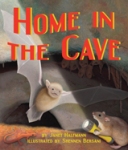
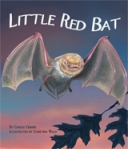
Blog: OUPblog (Login to Add to MyJacketFlap)
JacketFlap tags: orchids, pollen, wasps, *Featured, oxford journals, sexual reproduction, life sciences, Earth & Life Sciences, annals of botany, Alun Salt, aob, fascination of plants, sexual deception, flowers, Videos, Journals, nature, science, biology, Multimedia, botany, insects, Add a tag
“In the spring a young man's fancy lightly turns to thoughts of love” (Alfred, Lord Tennyson), but he could have said the same for insects too. Male insects will be following the scent of females, looking for a partner, but not every female is what she seems to be. It might look like the orchid is getting some unwanted attention in the video below, but it’s actually the bee that’s the victim. The orchid has released complex scents to fool the bee into thinking it’s meeting a female.
The post Sexual deception in orchids appeared first on OUPblog.
Blog: the dust of everyday life (Login to Add to MyJacketFlap)
JacketFlap tags: ARBORDALE, WINDY, BEAR, POLLEN, THEMED ART, Shennen Bersani, Add a tag
Blog: (Login to Add to MyJacketFlap)
JacketFlap tags: allergies, pollen, south, yankee, Learned Along the Way, Relationships, humor, Spring, Southern, Add a tag
Welcome to the South! But beware – we have some surprises for you. If you are just passing through on the way to the beach, leave your car parked in Chik-fil-A’s parking lot long enough to get a sandwich and you’ll find it. The yellow nightmare that welcomes spring here every year: pollen.
We are used to it. We don’t love it, but accept it as one of the few drawbacks of living in God’s Country. I wonder what the Union soldiers thought of the yellow cloud in April of 1864. Did it slow them down or just shock the troops and make them sick along the way? I can’t imagine muskets are easy to aim anyway, but I’m guessing more than a couple Southern soldiers escaped the bullet because of the itchy eyes and runny nose of the enemy.
Despite our ideological divide, the Confederacy was short lived and we are united. This unity allows many Yankees to set up residence here when they get sick of the cold weather and frosty attitudes up north. I’m told they were called ‘carpetbaggers’ back in the day. We have nicer names for them now (when they are in earshot). We sell them our cow pastures at over-inflated prices and say things like “Bless your Heart”, which they think is nice but is actually a veiled insult.
Just kidding (except about BYH) – everyone is welcome here.
I had a humorous run-in with pollen at our first home. It was a cute little starter home that had one issue – when it rained, the run-off from the street came down our driveway and off into the side yard to a retaining ditch. You can never see something like that unless you happen to be visiting in the rain before the purchase. We weren’t and the community real estate agent didn’t share that fact. He was from Connecticut. Anyway, the first time it rained in April, our entire driveway and yard was painted yellow with pollen run-off. Being an inexperienced home-owner and relatively dull anyway, I marched up the street in the rain to confront whoever was spilling yellow paint into my yard. I figured it out fairly soon.
Now I have a new boss moving from New Jersey. He seems like a really nice guy and I look forward to working with him. I wonder how he and his family will feel about Johnny Reb’s revenge. They will mostly likely wait to move until after school is out and will miss it this year. So the question is, should I warn him? Or let him enjoy the surprise in 2015…

♦
Photo credits: “I Heart Pollen !” by Brooke Novak & USGS Native Bee Inventory and Monitoring Laboratory from Beltsville, USA
Blog: OUPblog (Login to Add to MyJacketFlap)
JacketFlap tags: flowers, Journals, bees, biology, ecology, pollen, biodiversity, bumblebee, bumblebees, Editor's Picks, *Featured, oxford journals, Science & Medicine, Earth & Life Sciences, annals of botany, english gardens, michael hanley, palaearctic, by victorllee, Add a tag
By Michael Hanley
Urban gardens are increasingly recognised for their potential to maintain or even enhance biodiversity. In particular the presence of large densities and varieties of flowering plants is thought to support a number of pollinating insects whose range and abundance has declined as a consequence of agricultural intensification and habitat loss. However, many of our garden plants are not native to Britain or even Europe, and the value of non-native flowers to local pollinators is widely disputed.
We tested the hypothesis that bumblebees foraging in urban gardens preferentially visited plants species with which they share a common biogeography (i.e. the plants evolved in the same regions as the bees that visit them). We did this by conducting summer-long surveys of bumblebee visitation to flowers seen in front gardens along a typical Plymouth street, dividing plants into species that naturally co-occur with British bees (a range extending across Europe, north Africa, and northern Asia – collectively called the Palaearctic by biologists), those that co-occur with bumblebees in other regions such as southern Asia, and North and South America (Sympatric), and plants from regions (Southern Africa and Australasia) where bumblebees are not naturally found (Allopatric).
Rather than discriminating between Palaearctic-native and non-native garden plants when taken together, bees simply visited in proportion to flower availability. Indeed, of the six most commonly visited garden plants, only one Foxglove (Digitalis purpurea – 6% of all bee visits) was a British native and only three garden plants were of Palaearctic origin (including the most frequently visited species Campanula poscharskyana (20.6% of visits) which comes from the Balkans). The remaining ‘most visited’ garden plants were from North America (Ceanothus 11% of visits) and Asia (Deutzia Spp 7% of visits), while the second most visited plant, Hebe × francisciana (18% of visits) is a hybrid variety with parents from New Zealand (H. speciosa) and South America (H. elliptica).
However a slightly different pattern emerges when we consider the behaviour of individual bumblebee species. This is important because we know from work done in natural grassland ecosystems that different bumblebees vary greatly in their preference for native plant species. Some bumblebees visit almost any flower, while others seem to have strict preferences for certain plants. The latter group (‘dietary specialists’) include bees with long tongues that allow them to access the deep flowers of plants belonging to the pea and mint families that short-tongued bees cannot. One of these dietary specialists, the aptly named ‘garden bumblebee’ (Bombus hortorum), showed a strong preference for Palaearctic-origin garden plant species (78% of flower visits by this species); although we also saw this species feeding on the New Zealand-native, Cordyline australis. Even more interesting was the fact that our most common species the ‘buff-tailed bumblebee’ (B. terrestris) appeared to favour non-Palaearctic garden plants (70% of all visits) over garden plants with which it shares a common evolutionary heritage (i.e. Palaearctic plants). So it seems that any preference for plants from ‘home turf’ varies between different bumblebees; just like in natural grasslands, some bees are fussy about where they forage, and others not.
So what should gardeners do to encourage pollinators? Our results suggest that it is not simply a question of growing native species even if this is desirable for other reasons, but that any ‘showily-flowered’ plant is likely to offer some forage reward. There are caveats, however. Garden plants that have been subject to modification to produce ‘double’ flowers that replace or obscure the anthers and carpels that yield pollen and nectar (e.g. Petunias, Begonias, and Hybrid Tea roses) are known to offer little or no pollinator reward. A spring to autumn supply of flowers of different corolla lengths is important to provide both long- and short-tongued bumblebees with nectar. A reliable pollen supply is particularly important during nest founding through to the release of queen and male bees at the end of the nest cycle. Roses and poppies are obvious choices, but early season willows also offer pollen for nest-founding queens. Potentially most crucial of all however, are the pea family as they offer higher quality pollen vital for the success of the short-nest cycle, specialist bumblebees such as B. hortorum. It is also important that access to what gardeners refer to as ‘weeds’ is available. Where possible gardeners can set aside a small area to allow native brambles, vetches, dead nettles, and clovers to grow, but as long as some native weed species are available in nearby allotments, parks, or other green spaces, we suggest that a combination of commonly-grown garden plants will help support our urban bumblebees for future generations.
Dr Michael Hanley is Lecturer in Terrestrial Ecology at the University of Plymouth. He is co-author of the article ‘Going native? Flower use by bumblebees in English urban gardens’, which is published in the Annals of Botany.
Annals of Botany is an international plant science journal that publishes novel and substantial research papers in all areas of plant science, along with reviews and shorter Botanical Briefings about topical issues. Each issue also features a round-up of plant-based items from the world’s media – ‘Plant Cuttings’.
Subscribe to the OUPblog via email or RSS.
Subscribe to only earth, environmental, and life sciences articles on the OUPblog via email or RSS.
Image credit: Bumblebee on apple tree. By Victorllee [CC-BY-SA-3.0], via Wikimedia Commons
The post Bumblebees in English gardens appeared first on OUPblog.
Blog: Monday Artday (Login to Add to MyJacketFlap)
JacketFlap tags: pollen, microscope, invisible, microscopic, paramecium, science, Add a tag
My next two paintings in the "Invisible to the Naked Eye" series - the first one is inspired by paramecium, the second by pollen.

Blog: Yesisedit's Weblog (Login to Add to MyJacketFlap)
JacketFlap tags: honey, pollen, Thoughts, Art, Poem, bees, Children's book, funny, Stories and art, Say it ain't so, Add a tag
I like Bee much better than Bunny.
It’s not the nose ya know, it’s the honey.
Don’t get me wrong, Bunnies are fun when they sneeze but have you ever looked at a Bees knees?
Now there is a thing to marvel, a magnificent sight! Bunnies are cute but their knees are hidden so tight.
Then you may like Kangas and Roos but you have to go to Australia or zoos.
There are Bears and we mention they’re grumpy but who cares, their knees are all lumpy.
There’s Pandas of course and then there’s the horse you say but they don’t have six knees all going a-splay.
Now I admit the Bee is plump, not like the Pig though, who’s got such a rump!
And eyes for that matter count for so little. You know Tarantula and Dragonflies are not caught in the middle!
Crabs have legs that look so askance when they walk in the mud it’s such an odd dance.
No it’s the Beez Kneez for me, this I know. Where do they go in the winter when it begins to snow?
Yup they gather the pollen on knees and bee line for home and I follow them there, to the honeycomb.
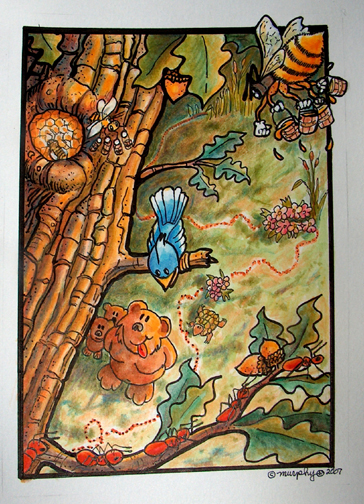

Blog: Children's Illustration (Login to Add to MyJacketFlap)
JacketFlap tags: Betsy Lewin, Harry Bliss, John Grandits, Joanna Cotler, Dilys Evans, Add a tag
WHAT’S SO FUNNY? Video Stream: Click Here
With Dilys Evans, Harry Bliss ,Betsy Lewin, Joanna Cotler, and John Grandits
(Note: The audio goes out for a few minutes at the beginning--but it returns!)










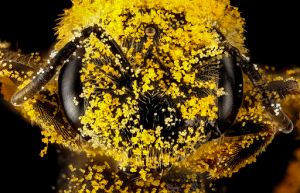

i say bless his heart <3
Do you mean it sincerely? Because most of the time when it drips syrupy sweet from a southerner’s mouth, it means more “poor old fool” than anything else.
I use Bless you heart both way, sincerely and viciously, keeps’um guessing :)
Excellent! Make ‘em think
“I marched up the street in the rain to confront whoever was spilling yellow paint into my yard” – Mark, chucking my way through this lovely piece – that sentence so connected.
(I won’t mention chasing some inebriated youngsters along several streets in icy conditions, not even half-clothed at 2am one winter morning – determined to reclaim our wheelie bin they had taken for a ride)
I think that was me! Had a great ride on that bin!
There is really no answer to that. :-)
The Yellow Fog has not yet arrived in SW Missouri. However, we’ve had one or two Dirt Rains so far. The pollen fogs should arrive soon. Store shelves are stocked with Benadryl and tissues. Don’t warn the norterner. It’s part of the initiation, right?
Absolutely. But it will be hard to act surprised when he comes in the office all red-nosed.
That made me laugh out loud! :)